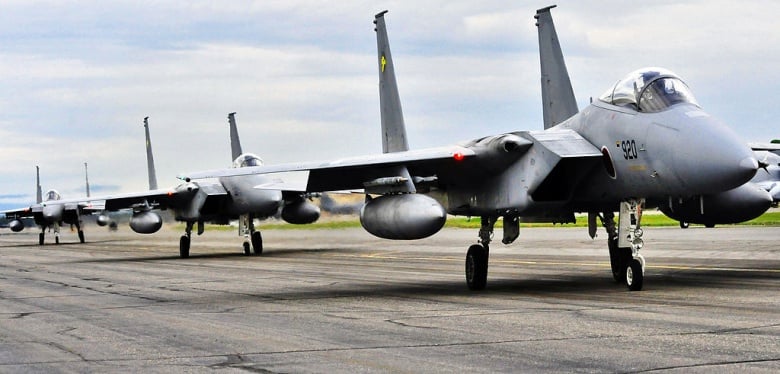Cinco armas japonesas que China deberia considerar(en inglés)
Página 1 de 1.
 Cinco armas japonesas que China deberia considerar(en inglés)
Cinco armas japonesas que China deberia considerar(en inglés)
http://nationalinterest.org/feature/five-japanese-weapons-war-china-should-fear-10660
While China's rising military might gets all the press, Japan's Self-Defense forces pack quite a punch.
Kyle Mizokami
June 14, 2014
Sino-Japanese relations have been deteriorating since 2010. What started as a dust-up over a Chinese fisherman arrested for fishing in Japanese waters has escalated into a series of unpleasant incidents between the two countries, mostly in and around the uninhabited, and largely unappealing Senkaku Islands (Diaoyu Islands in China.)
For now, incidents have largely been restricted to demonstrations by the coast guards of both sides and military aircraft encounters. Yet with each year, relations between China and Japan have steadily deteriorated. Unchecked, someday what may seem like routine unpleasantness could spiral into military action. Listed below for your consideration are five Japanese weapons of war that Beijing should think carefully about if the unthinkable ever occurred:
Soryu-class Diesel Electric Submarines
Japan’s Soryu-class submarines are some of the most advanced non-nuclear attack submarines in the world. Displacing 4,100 tons submerged, the subs can make 13 knots on the surface and up to 20 knots submerged. Four Stirling air independent propulsion systems allow the Soryu class to remain underwater far longer than most diesel electric submarines.
The Soryu class is armed with six bow-mounted torpedo tubes, with a total of 20 Type 89 high-speed homing torpedoes and American-made Sub-Harpoon missiles. Japan’s submarines could also be the delivery vehicles for cruise missiles, should the concept of preemptive strikes, currently being debated in Japanese politics, become a reality.
There are currently eight Soryu-class submarines, with more under construction. In response to increased tensions with China and a growing People’s Liberation Army Navy submarine fleet, in 2010 Japan decided to increase its own submarine force from 16 to 22.
Japan’s postwar submarine doctrine concentrates submarines at a number of key invasion routes to Japan: the Tsugaru Strait, Tsushima Strait, Kanmon Strait, and the Soya Strait. This concentration is a Cold War holdover, from when Japan expected that Soviet Union might invade during wartime. A more China-centric deployment plan, especially with the Senkakus and Ryukyu islands in mind, could see more forward deployments into the East China Sea and Sea of Japan.
Japan’s submarine fleet is particularly worrisome to China because of Beijing’s traditional weakness in anti-submarine warfare (ASW). China has not practiced ASW in wartime and has been institutionally deficient in both skills and assets. Japan, on the other hand, has operated submarines for many decades. Japanese submarine crews are reportedly well trained, on par with their American counterparts.
F-15J Fighters
Next up is the cream of Japan’s fighter force, the Air Self Defense Force’s F-15J air superiority fighter. The twin-engined F-15J is the Japanese version of the American F-15 Eagle, with minor differences and manufactured domestically by Mitsubishi Heavy Industries.
The F-15J is armed with the AAM-5 infrared homing missile, similar to the American Sidewinder missile, which it replaced. Complementing it will be the AAM-4B, a medium-ranged radar-guided missile and one of the few missiles in the world with an active-array radar seeker. Active-array radar missiles, of which China has none, dramatically increase both the range and the lock-on capability of radar-guided missiles, giving the F-15J a distinct advantage over Chinese adversaries.
More than 200 F-15Js have been built. In order to keep these 30+ year old planes competitive against the new generation of Chinese fighters, a dozen a year are upgraded with new electronic countermeasures (the Mitsubishi Integrated Electronic Warfare System), forward looking infrared and infrared search and track capability.
The F-15J is the front line of Japan’s military response to foreign military forces. In 2013, the ASDF performed 567 air intercepts of foreign aircraft approaching Japanese airspace, a new record. The single squadron of 20 F-15Js stationed on Okinawa covering the Senkaku and Ryukyu islands will be reinforced with another squadron, and the possibility of stationing a small detachment on the island of Yonaguni is being studied.
Although an aging design, the F-15J still represents a formidable challenge to the People’s Liberation Army Air Force (PLAAF), and after more than three decades of service is still arguably the equal of any operational Chinese fighter. Worldwide, the F-15 has a reputation as a particularly deadly fighter, with 104 aircraft kills and zero losses.
Atago-Class Guided Missile Destroyers
The two destroyers of the Atago class are Japan’s most capable surface combatants, floating arsenals designed to take on a variety of missions. At 10,000 tons fully loaded, the Atago destroyers weigh as much as Japan’s World War II era cruisers. The U.S.-designed Aegis radar system makes it a potent mobile air defense platform, capable of shooting down aircraft and ballistic missiles.
Atago-class destroyers are equipped with 96 Mk.41 vertical launch missile silos, each capable of holding a single SM-2 surface to air missile, SM-3 ballistic missile interceptors, or ASROC anti-submarine rockets. Anti-ship armament consists of eight SSM-1B anti-ship missiles, roughly equivalent to the American Harpoon missile, while gun armament is in the form of one five inch gun and two Phalanx close-in weapons systems. Finally, each Atago can engage submarines with a SH-60 Seahawk helicopter and six deck-mounted Type 73 anti-submarine torpedoes.
The Atago class is an enhanced version of the earlier Kongo class of destroyers, equipped with six more vertical launch cells and a helicopter hangar. Both classes feature the Aegis air defense radar system, however the Atagos were not initially equipped with the Aegis ballistic missile defense upgrade. In light of the North Korean and Chinese ballistic missile threat, two more of the Atago class will be constructed, and all four ships will receive the ballistic missile software upgrade. This will give Japan a total of eight destroyers capable of engaging ballistic missiles.
The Atago class, once upgraded, will represent a formidable air defense platform. In a wartime scenario China could be expected to launch barrages of short and medium range ballistic missiles against Japanese and American ships, air bases, and military facilities. Japan’s Aegis fleet would form a barrier against these attacks. A screen of Atago destroyers could also form a potent anti-aircraft defense over the Senkaku and Ryukyu islands. Armed with SM-2 Block IIIB anti-aircraft missiles with a range of 90 nautical miles, a single Atago can dominate 565 square nautical miles of airspace.
Izumo-Class “Multipurpose Vessels”
At 27,000 tons fully loaded and more than 800 feet long, the Izumo-class helicopter destroyers are the largest naval vessels constructed by postwar Japan. Officially a “helicopter carrier-type escort/destroyer,” Izumo was built at the Japan Marine United shipyards at Yokohama and is scheduled to join the fleet in March 2015. Two Izumo destroyers will be built, with the second ship not yet named.
The Izumo class, like the previous, smaller Hyuga class, bear a strong resemblance to aircraft carriers. Izumo is touted by the JMSDF as a multi-purpose vessel. With a full length flight deck and hangar, each Izumo can accommodate and service up to 14 helicopters. Armed with SH-60 anti-submarine helicopters, each Izumo could sweep a large area of water for submarines.
Japan’s new helicopter destroyers can be used in the amphibious role. During the 2013 US-Japan Dawn Blitz exercises JS Hyuga acted as an airfield at sea for CH-47 Chinook transport and AH-64 Apache attack helicopters of the Ground Self Defense Forces. In a pinch, Izumo could carry a battalion’s worth of troops from the 1st Airborne Brigade or Western Army Infantry Regiment and transport them to shore via helicopter.
Finally, it has been speculated that Japan could order a second batch of F-35 fighter bombers, this time the B model adopted by the U.S. Marines and Royal Navy, and operate them off its new “helicopter destroyers.” The F-35B could operate off the Izumo—and even Hyuga—destroyers, but there would have to be extensive modifications, including support for fixed-wing aircraft and hardening of the flight deck to withstand high temperatures generated in vertical takeoff and landing. It would be an expensive and politically risky move just to put a handful of aircraft at sea, but if Japan believed it is necessary for defense of the Senkaku and Ryukyu islands area, it could happen.
China fears the Izumo class because it is a versatile platform. As an ASW platform, it could sweep and clear vast areas of Chinese submarines. As an amphibious platform, it provides the capability for Japan to place troops on the ground on remote islands. And as an ad-hoc aircraft carrier, it could place a handful of stealthy 5th fifth generation fighter-bombers on a mobile platform in the East China Sea.
The United States Military
The presence of someone else’s military on this list may strike some as unusual, but let’s face it: the Treaty of Mutual Cooperation and Security Between Japan and the United States means Japan has the most powerful military in the world backing it up.
The entry of the U.S. into any Sino-Japanese conflict would be strictly conditional, of course. Japan would have to be the victim of armed attack and request American military assistance. But once it did and treaty conditions were adequately met, it would mean virtually the entire U.S. military machine, from the nuclear attack submarines at Guam to the B-2 bombers based in Missouri would be committed on behalf of Japan.
Such devotion to an ally is admirable, and the U.S.-Japan alliance has been one of the great successes of the postwar era. At the same time, the alliance was designed to resist the Soviet Union in an all-out war, not backstop Japan in a territorial dispute with China.
The entrance of the United States in a Sino-Japanese conflict would almost certainly result in a great power war. A conflict between the United States and China would dwarf any spat between Japan and China, have staggering global economic consequences, and involve two nuclear powers. As long as Japan’s territorial disputes fester and Japan insists on limiting defense spending to a mere one percent of GDP, the possibility that the United States could be pulled into a local crisis that escalates into a major war is very real.
Kyle Mizokami is a writer based in San Francisco who has appeared in The Diplomat, Foreign Policy, War is Boring and The Daily Beast. In 2009 he cofounded the defense and security blog Japan Security Watch. You can follow him on Twitter: @KyleMizokami.

ivan_077- Staff
-
 Cantidad de envíos : 7771
Cantidad de envíos : 7771
Fecha de inscripción : 14/11/2010
 Temas similares
Temas similares» Cinco armas indias que China deberíá considerar (en inglés)
» Cinco armas gringas que Beijing debería considerar (en inglés)
» Cinco armas chinas que Estados Unidos debería temer (en inglés)
» El Dragón contra los Guerreros del Tet: la disputa por los recursos en el mar.
» ¿Que mantiene despiertas a las naciones del Este de Asia? China.(en inglés)
» Cinco armas gringas que Beijing debería considerar (en inglés)
» Cinco armas chinas que Estados Unidos debería temer (en inglés)
» El Dragón contra los Guerreros del Tet: la disputa por los recursos en el mar.
» ¿Que mantiene despiertas a las naciones del Este de Asia? China.(en inglés)
Página 1 de 1.
Permisos de este foro:
No puedes responder a temas en este foro.

 Índice
Índice Últimas imágenes
Últimas imágenes Registrarse
Registrarse Conectarse
Conectarse